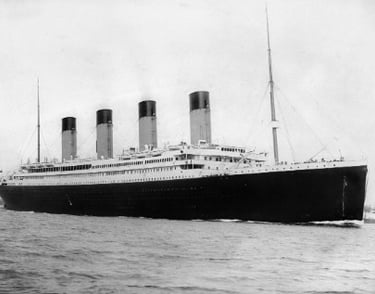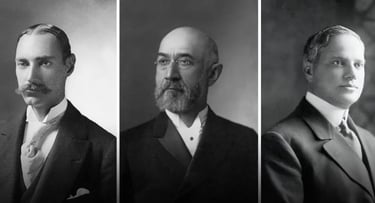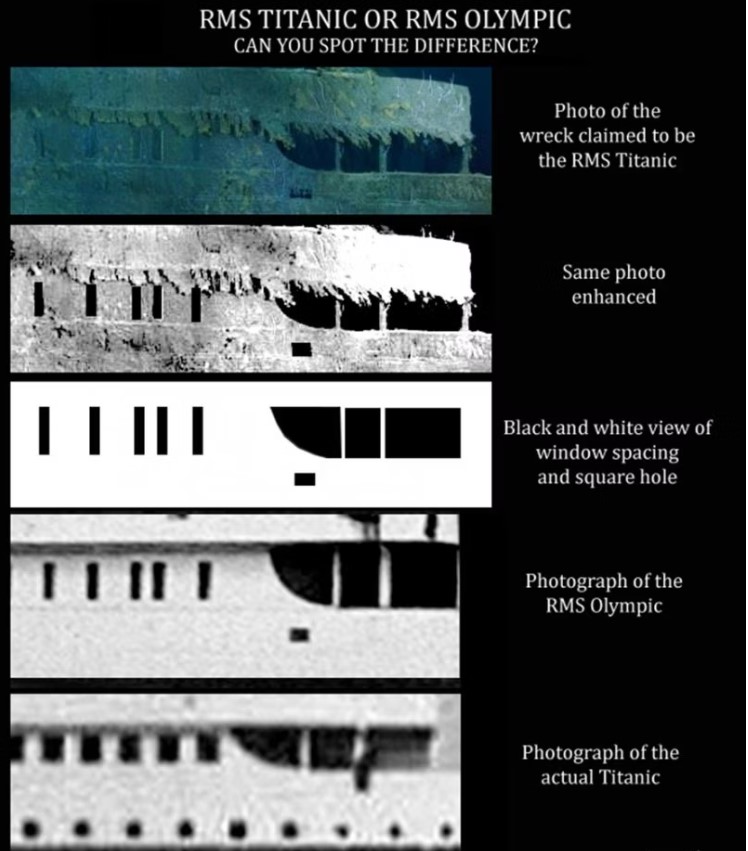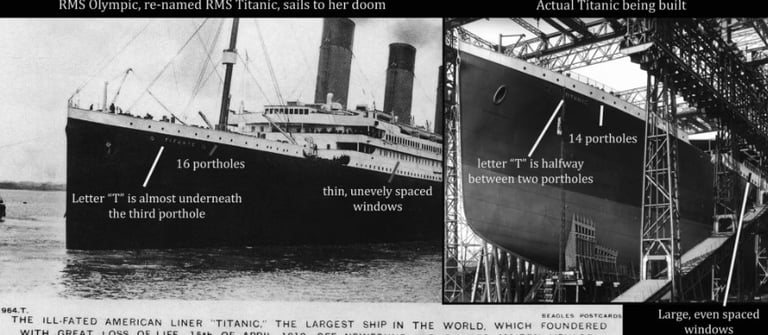Titanic
Here we will explore the theory that the Titanic never sank in 1912. Could the Titanic's sister ship the Olympic have sank in it's place?


According to the official story, late in the evening on April 14, 1912, the R.M.S. Titanic hit an iceberg and sank into the icy waters of the North Atlantic, killing 1,517 of the 2,223 passengers and crew members aboard.
The Olympic-class ocean liners were a trio of British ocean liners built by the Harland & Wolff shipyard for the White Star Line during the early 20th century. They were Olympic (1911), Titanic (1912) and Britannic (1914). All three were designed to be the largest and most luxurious passenger ships at that time, designed to give White Star an advantage in the transatlantic passenger trade.
Like Titanic, Olympic was designed by Thomas Andrews and literally built side by side to Titanic in the mammoth Gantries of Harland & Wolff’s shipyards. Olympic was completed and launched almost exactly twelve months before her infamous sister ship on September 20, 1910, and she had a successful maiden voyage on June 14, 1911.
The Titanic is one of the most famous maritime disasters of all time, but did the Titanic really sink on the morning of 15 April 1912?
There is two reasons as to why the Titanic or it's sister ship had to be sunk.
Firstly, In 1910, seven men met on Jekyll Island just off the coast of Georgia, USA to plan the formation of a new central bank, the Federal Reserve Bank, in order to usurp the control of money creation from the US Government and place it into private hands. Nelson Aldrich and Frank Vanderlip represented the Rockefeller financial empire, Henry Davidson, Charles Norton and Benjamin Strong represented J.P. Morgan and Paul Warburg represented the Rothschilds banking dynasty of Europe. These men all took great pains to conceal their identities and their dastardly mission, all of them travelling incognito.
The Morgans, the Warburgs, the Rothschilds and the Rockefellers are more often than not, fierce competitors for short-term profits, yet are prepared to commit to joint ventures whenever necessary to further the greater ‘cause’. They established the US national banking cartel that is the Federal Reserve Bank in 1913. According to G. Edward Griffin in 'The Creature from Jekyll Island’ “…it tells a story of how bankers have lured politicians with easy money and end up in control of most of the world.” They are all part of and therefore controlled by the Elite hierarchy. These most powerful of families constantly strive to do whatever is necessary to destroy constitutional liberty in America (and worldwide).
However there was three very powerful rich men who were opposed to the creation of the Federal Reserve. But unfortunately they were all aboard a ship called the Titanic when it sank in 1912, one year before the Federal Reserve came into being, what a coincidence.
Three of the richest and most important of the opponents of the Fed were Benjamin Guggenheim, Isador Strauss, the head of Macy’s Department Stores, and John Jacob Astor (below), probably the wealthiest man in the world. Their total wealth, at that time, using dollar values of their day was more than 500 million dollars. They were coerced on to the ship to their deaths by J.P Morgan, the Rothschild banking front in America. They had to be destroyed because the Rothschild banking cartel knew these men would use their wealth and influence to oppose a Federal Reserve Bank as well as World War 1 which was being planned.


Incidentally, does it not seem rather strange in hindsight that although the Olympic was the first of the (virtually) identical triplet ‘sisters’ to be completed and enter service, she was never given the publicity, nor enjoyed the huge public acclaim that her younger sister enjoyed, the following year? Why would that be? Surely the big fanfare and carnival-like atmosphere surrounding the maiden voyage of these ‘floating wonders of the age’ should have been reserved for the first one to enter service, Olympic and not the second one, Titanic? Indeed, in comparison, the occasion of Olympic’s maiden voyage in 1911 passed relatively quietly. Olympic was completed and launched almost exactly twelve months before her infamous sister ship on September 20, 1910, and she had a successful maiden voyage on June 14, 1911.
Could the huge accolades and publicity accorded to Titanic’s maiden voyage possibly have been part of a conspiracy to lure the rich and famous to her in great numbers for reasons that will become apparent shortly?
John Pierpoint (JP) Morgan was in control of the White Star shipping line as well as a significant portion of all American financial and manufacturing industry at the turn of the twentieth century. In 1908, he made the decision to build a brand new class of luxury liners to enable the wealthy to cross the Atlantic seaways in previously undreamed-of opulence. This class of ships was named the ‘Olympic’ class and construction of the giant vessels the ‘Olympic’, the ‘Titanic’ and the ‘Britannic’ began in 1909 at the Harland and Wolff shipyard in Belfast, Ireland.
Unfortunately for Morgan and his personal bank balance, this money-making venture went a little awry. The Olympic, the first one of the three sister-ships to be completed (followed by Titanic and then Britannic), was involved in a rather unfortunate accident caused by a heavy collision with the British Royal Navy cruiser, HMS Hawke in September 1911 in Southampton Water off the south coast of England, a few weeks after its maiden voyage and had to be extensively ‘patched-up’ before embarking on the return journey to Harland and Wolff ’s shipyard in Belfast in order to undergo full damage assessment and proper repair work.
A Royal Navy enquiry into the accident, not unexpectedly, found the crew of the Olympic and thus the White Star Line culpable for the collision and this in effect meant that the White Star Line’s insurance was null and void and the company would therefore be liable to pay all the costs of the repairs to both ships themselves. To cut quite a long story short, this meant that the White Star Line was out of pocket to the tune of at least £800,000 (around £60m today) for repairs and lost revenues whilst the ship was unable to ply its trade back and forth across the Atlantic. With the massive financial investment of the White Star company needing to be repaid sooner rather than later, this put severe pressure on the organisation and impacted upon the final completion of the Titanic, further contributing to the financial black hole in which White Star now found itself increasingly being consumed. However, for JP Morgan and the White Star Line, even worse news was to come. The damage to the Olympic was far more severe than anyone had expected. It did not help matters at all when the Olympic was involved in a further collision, this time it was believed, with a partially submerged wreck. Although the damage inflicted in the Hawke incident had been shored-up as well as it could have been, there were rumours circulating amongst the Harland and Wolfe workforce and the White Star crews that all was not well with Olympic and this seemed to be confirmed when it lost a propeller blade in the above, second incident, causing further severe vibrational damage to the already damaged ship. It is believed that the keel of the ship was actually twisted and therefore damaged beyond economic repair, which would have effectively meant the scrapyard for her. If this had been the case, it is virtually certain that the White Star Line would have been bankrupted, given its now precarious financial situation.
‘...it took a fortnight [two weeks] of emergency patching to Olympic’s hull before she was in any fit state to attempt the journey from Southampton to Belfast for more complete repairs. Able to use only one main engine, the crippled liner made the voyage at an average speed of 10 knots, wasting the exhaust steam from the one usable engine. This steam would normally have driven the central turbine engine, which shows that this engine, its mountings or shafting had been damaged in the collision. As this engine sat on the centreline of the vessel, immediately above the
keel, which the propeller shaft ran through, we can reasonably assume that the keel was damaged’. Robin Gardiner, ‘Titanic, the Ship that Never Sank?’


…The plan was simple, switch Olympic with her sister ship Titanic and sink it to claim compensation. No one would know they had swapped the ships (except the people in charge: J.Bruce Ismay, Lord Pirrie, Thomas Andrews and J.P.Morgan) as if you looked at the ships when they were sitting beside each other you would not know which one was which unless you looked at the name plates on both ships.
Video
In his well-researched work, Robin Gardiner presents a long series of credible testimonies, indisputable facts and evidence, both written and photographic, that would seem to point to the fact that the two ships were switched with a view to staging an iceberg collision or other unknown fatal event, with the Titanic (originally the Olympic) and many of its passengers and crew being sacrificed in an audacious insurance scam which would save the White Star Line from financial ruin.

Morgan and the other co-conspirators hit upon a really neat ‘kill two birds with one stone’ solution, then not only would White Star have successfully solved the Olympic problem and thus its own financial worries, but J.P. Morgan would also have fulfilled his wishes to implement his plan to establish the Federal Reserve with little or no powerful opposition to thwart him. Perfect.
All three (along with many other prominent people of the day) were subtly enticed
to board the by-now hyped-up to be, highly prestigious maiden voyage of the Titanic
with a view to ending their opposition to the Federal Reserve plans and thus an
additional reason for the ship's destruction was a stand-off between the mega-rich
whereby Guggenheim, Strauss and Astor could be eliminated. They had to be
destroyed by a means so outrageous and fantastic that no one would suspect they
were murdered and also using a method that would completely obscure the real
reason for their demise. Simply arranging for all three men to undergo separate
‘accidents’ would have appeared far too suspicious, so they had to be lured to the
same place at the same time and Titanic’s pre-determined, ill-fated maiden voyage was
the solution to the problem. Could this have been the real reason for all the
hullabaloo and hype surrounding Titanic’s maiden voyage despite the fact that the
Olympic was accorded a much less publicised or flamboyant ‘send-off ’ on the 14th
June 1911, even though she was after-all, the first one off the production line?
Morgan himself was supposed to be travelling on the ship, but as was always
intended, he had a ‘last minute change of plan’ due to a ‘bout of ill health’ and
significantly failed to show at Southampton at the appointed time and so his personal
stateroom remained empty as the giant vessel pulled away from Southampton docks
on the afternoon of the 10th April 1912, to the delight of the cheering multitudes on the quayside.
Even if my hypothesis could be criticised by some as mere conjecture, the true
Titanic story is still very, very different to the official, ubiquitous one that we see
depicted in books and numerous films and documentaries that have been spawned by
this tragic incident. The book, published in the 1950s and the feature film of the
same name, ‘A Night to Remember’ (Longmans, Green & Co, 1956) by Walter Lord
is the source most responsible for the Titanic myths and legends still prevailing today.
Lord was a ‘former’ member of the US intelligence services (OSS and CIA) but given
the fact that it is well known that anyone who has been a member of these
organisations always in effect remains a member, can we really rely on his accounts or
are they just more subterfuge amongst a morass of contradictory stories surrounding
the event? What would motivate a former member of one of the world’s elite security
services to write a book about an accident involving an ocean liner? As always seems
to be the modus operandus in any suspected conspiracy, we are bombarded with
these so-called ‘facts’ by the controlled media, to such an extent that we believe that
they cannot possibly be untrue or deliberately misleading. However, many of the
major Titanic ‘facts’ have subsequently been proven to be false but somehow the same
version of the story still persists as the absolute de facto truth. Such is the power of
propaganda on the human mind and symptomatic of the methodology by which most
history is perverted.
Robin Gardiner further stated, “As I delved deeper into the story, more and more
inconsistencies became apparent. Inconsistencies that individually meant little but
collectively pointed to a grimmer reality than that usually depicted in the heroic
legend”.
He continues, “Officers who were later acclaimed as heroes were exposed as
anything but. One in particular removed a little boy from a lifeboat at gunpoint,
before escaping in that same boat himself”.
“Descriptions of the collision and damage supposedly sustained by Titanic do not
agree. The ‘slight scrape’ with the ice that was hardly noticed by most aboard
contradicts solid evidence of structural damage at least 5½ feet (1.6 metres) within the
outer hull of the vessel”.
“Then came evidence to show that the ice the ship encountered was seen first not
500 yards (480 metres) ahead but more like 11 miles (17km). I began to wonder if
perhaps the sinking of the Titanic might not have been an accident after all”. [my
emphasis – JH]
Indeed, did Titanic actually strike an iceberg at all? We only have the eye-witness
testimony of four people believe it or not, with which to confirm or deny this fact.
First Officer Murdoch would have been the fifth witness but he did not live to tell his
story. Gardiner himself offers no opinion on this theory, but the copious amounts of
ice on the deck of Titanic reported by many survivors could easily have been the
result of any collision dislodging the icy build-up on masts, funnels etc. or it could
even have been easily shaken loose from the hundreds of yards of overhead rigging
and wiring by the thrusting of the ships engines abruptly into reverse. It was after all,
an extremely cold, still night with temperatures below freezing.
There have been many legends surrounding the incident but there is plenty of
concrete evidence that Titanic was not the only ship at that precise location that
night. For example, there is a photograph in existence of a drifting lifeboat that can
be discounted totally as being from Titanic herself due to being of different colours
and design to Titanic’s lifeboats.
Then there is the gouge in the side of the ship itself – 1.6 metres deep through the
outer steel plates and into the inner skin! Compacted ice is known to be very strong,
indeed stronger than steel under certain conditions, but there is no evidence that I am
aware of that it is capable of doing such catastrophic damage to steel. In addition the
relatively narrow, 15cm puncture line in the ship’s hull in conjunction with a
penetration of around 1.6m would indicate an almost impossibly-shaped ice outcrop
colliding with the ship at exactly the most critical point.
Whatever the real truth, the point here is surely that there exist so many different
possibilities that the official story is probably just an elaborate fabrication. Both the
American and British official inquiries were even thought at the time to be pretty
much a ‘whitewash’, with much evidence either ignored and eye-witness testimonies
being twisted or indeed fabricated to fit the ‘official’ story. It is staggering also to
report that of the 102 witnesses called to the British enquiry, only two were
passengers (the influential Gordons of the famous London gin company) and it is
even more surprising to learn that none of the witnesses (crew or passengers) were
allowed to offer their own first-hand evidence of any kind and were strictly restricted
to the simple answering of questions without elaboration. By any standards at all, this
sounds very much like a ‘whitewash’ to me. The passage of time has also served to
cloud the mystery still further.
We should also note that amongst all the myriad of (probably) deliberately
conflicting information unearthed by the two inquiries, the most puzzling of all is the
situation regarding the ‘yellow-funnelled steamer’ observed in the proximity of Titanic
by the officers and crew of Californian at around the time of the incident and which
has never been either identified or explained away at all. Significantly, this odd
occurrence does not even warrant a mention in any surviving Titanic legends – very
strange to say the least, despite its appearance in several contemporary newspapers.
The crew of this ship (who or whatever she was) must have been aware that they were
in the approximate area of the Titanic’s demise at the same time, so why did no-one
from the ship come forward to volunteer any evidence or information or simply to
state that they had seen nothing significant, instead of disappearing into the mists of
history forever? It also begs the question as to why no attempts were made to
discover the identity of this ship either by the inquiries or subsequently by
independent investigators. Even if attempts were made at the time, as far as I am able
to tell, they have been very successfully covered-up and no evidence remains today.
Could this mysterious yellow-funnelled vessel have been responsible for the
devastating damage to Titanic in any way? I personally believe it is a very strong
possibility and that the ‘iceberg collision’ is just a cover story concocted to protect the
guilty.
“...I saw another steamer approaching, and asked [the wireless operator] what
vessels he had within reach; he replied: ‘The Titanic’, whereupon I replied, ‘That is not
the Titanic; she is too small and hasn’t enough lights.’ Shortly afterwards this steamer
stopped and was bearing S.S.E. about five or six miles from our position. ...the chief
officer was sweeping the southern horizon with his glasses, and finally reported he saw
a four-mast steamer with a yellow funnel to the southward of us, and asked if we
should try to get down to have a look at her.” Captain Lord of Californian in an
interview with an American newspaper, 1914
Lord became the official scapegoat for the disaster for his so-called ‘negligence’ in
not rushing sooner to Titanic’s aid as the Californian was probably only about 11 miles
from her when she went down.
But would these people murder so many in cold-blood simply for financial gain?
Unfortunately this is just one small example among many, many others too numerous
to mention. As I state elsewhere in various chapters of this book, these multigenerational
mass-murderers routinely kill and even commit genocide to maintain
their own status, wealth and positions of power and promote their own agenda. Any
person or persons capable of sacrificing billions of people’s health, wealth and
prosperity for generations to come, in a scheme to gain financial control of the world
for themselves, would stop at nothing at all to achieve their own selfish ends.
Murdering a ship-full of innocent passengers including women and children simply for
financial gain in the form of a fraudulent insurance payout, would to my mind make
them more than capable of sinking the same ship of people just to dispose of three
powerful enemies who stand in the way of their nefarious ambitions. To them it is
nothing personal, just ‘business’. Where have we heard that before? The presence of
both motives indeed, I believe, makes the scenario doubly plausible.
In December 1913, the Federal Reserve System thus came into being without
serious opposition in the United States and very shortly afterwards, the Elite had
accrued sufficient funding through the despicable methods of the Federal Reserve
Bank to move to the next phase of their plan and start World War I
https://www.express.co.uk/news/world/310263/The-Titanic-cover-up




When the Titanic was pictured while being built it had 14 evenly spaced portholes but when it left Southampton on doomed maiden voyage on April 10th 1912 it had 16 unevenly spaced portholes.